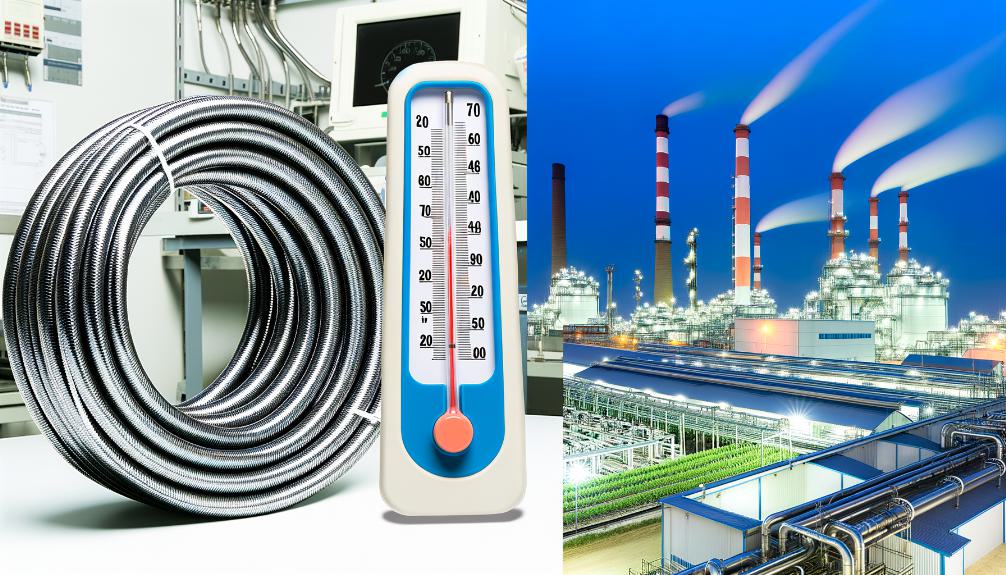
When you're working with composite hoses, it's crucial to match the hose to the right temperature range for best performance. For low-temperature applications, they're flexible down to freezing, making them ideal for transporting liquefied gases. In moderate temperatures, ranging from 5°C to 100°C, their chemical and thermal stability shine, supporting a variety of industrial applications. High-temperature operations, prevalent in sectors like metallurgy, demand hoses capable of handling intense heat without degradation. Ensuring the correct hose choice enables safety and efficiency, paving the way for further exploration of their applications in specific environments.
Low-Temperature Applications
Composite hoses retain their flexibility and structural integrity in low temperatures, making them suitable for transporting substances like liquefied gases and chemicals in cold environments. You'll appreciate the cold resilience of these hoses, which is important when handling materials prone to freezing. The structural composition of composite hoses includes multiple layers of thermoplastic and fabric, which not only provide superior insulation but also guarantee that the hose remains pliable even under extreme cold conditions.
This attribute is essential for maintaining the flow and preventing blockages that can occur when temperatures drop. Additionally, the built-in freeze protection in these hoses minimizes the risk of the transported substances crystallizing, which can lead to ruptures or leaks. By choosing a hose with high-quality insulation properties, you're ensuring that the thermal characteristics of the fluid inside are maintained, preventing phase changes that could compromise the integrity of both the hose and the material being transported.
When selecting a composite hose for low-temperature applications, it's important to verify that it meets the specific thermal requirements of the substances you're handling. Make sure the materials used in the hose construction are rated for your particular environmental conditions to maintain safety and efficiency in operations.
Moderate-Temperature Uses
Handling moderate temperatures, you'll find that composite hoses offer excellent performance and durability for a wide range of industrial applications. These hoses are specifically designed to manage temperatures typically between 5°C and 100°C. In this moderate range, the structural integrity of composite hoses is maintained, ensuring a long service life and consistent performance.
The chemical resistance of these hoses is particularly notable. You're dealing with materials that can withstand exposure to a variety of chemicals without degrading. This is important in applications like chemical processing or the transfer of petrochemicals, where fluid integrity is paramount. The construction of composite hoses, including layers of thermoplastic and fabrics, provides a barrier against chemical permeation, safeguarding both the hose and the environment from contamination.
Furthermore, the environmental impact of using composite hoses in moderate temperatures is minimized. These hoses are engineered to reduce emissions and leaks. They're also often made from recyclable materials, promoting environmental sustainability. The durability and efficiency of composite hoses not only enhance operational reliability but also contribute to a reduction in waste and resource consumption, aligning with broader environmental goals.
High-Temperature Operations
While moderate temperatures are well-managed by composite hoses, they also excel in high-temperature operations, often required in industries like metallurgy and aerospace. You'll find that material selection becomes critical when operating under these conditions. Composite hoses designed for high temperatures are typically constructed from materials that can withstand intense heat without degrading. These materials include specialized rubber compounds and layers of heat-resistant textiles and wire.
As you consider these hoses for your high-temperature applications, it's essential to understand the specific temperature ranges they support. Manufacturers generally specify the maximum temperature threshold, but you mustn't overlook the importance of gradual temperature increases. Sudden changes can compromise hose integrity.
Installation challenges also merit careful consideration. The correct installation of high-temperature hoses is paramount to guarantee safety and functionality. This involves securing connections and using protective measures to shield the hose from external heat sources and mechanical damage. Furthermore, regular maintenance checks are important. These include inspection for any signs of wear or thermal damage and immediate replacement if any compromises are detected.
Conclusion
To sum up, when selecting composite hoses for your applications, it's essential to match the hose's temperature capabilities with your operational needs.
For low-temperature environments, make sure the hose maintains flexibility and strength. In moderate temperatures, prioritize durability and chemical resistance. High-temperature operations demand hoses that can withstand extreme heat without degrading.
Carefully consider these ranges to optimize performance and safety in your specific setting, enhancing both efficiency and longevity of your equipment.
© Copyright 2024. All RIghts Reserved
